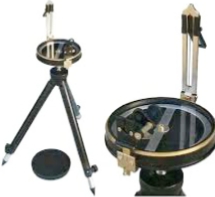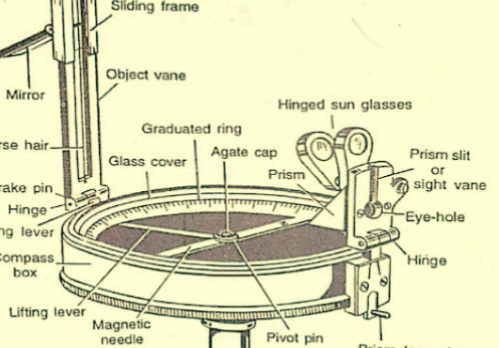In this article, we will discuss about prismatic compass. It is a surveying instrument. We will know all the key details about prismatic compass.
Let’s Start.
Table of Contents
Introduction Of Prismatic Compass
A prismatic compass is a surveying tool commonly used to determine traversal bearings, angles between them, waypoints, and directions.
It is known as a prismatic compass because its main component, a prism, is utilized to take observations more precisely.
Description
A magnetic compass is used in a compass survey to measure the direction of a survey line and a tape or chain is used to measure the length of the survey line. The crosshair is often guided by a compass. The bearing of a line in relation to a magnetic needle is determined by a compass. It is possible to compute the included angle using both clockwise and counterclockwise-compatible formulas.
See the below image of prismatic compass instrument.

Check out the prismatic compass diagram as shown below.

The surveyor takes two fore and fore bearing measurements for each line of traverse. If the neighborhood attraction is insignificant, he should actually be 180 degrees off.
How To Use Prismatic Compass?
You can use a tripod or a hand-held prismatic compass at survey line stations. Once you can see the halves of the range stick through the aiming flag of the mirror, manually rotate the compass.
Install the ball and socket that supports the spindle of the prism compass stand, then screw into the station point to adjust the prism for focusing, leveling and centering.
While taking the readings, the surveyor should be facing the proper direction. Avoid letting the magnetic needle on the compass freely rotate by keeping electronics and metal objects away from it.
Difference Between Prismatic Compass And Surveyor Compass
Here are the major differences between prismatic compass and surveyor compass.
| Prismatic Compass | Surveyor Compass |
|---|---|
| Used for basic directional measurements and orientation. | Used for precise surveying and mapping tasks. |
| Compact and portable design. | Larger and more precise construction. |
| Magnetic needle reading or prism observation. | Graduated circle or scale with a vernier for reading angles and bearings. |
| Moderate accuracy for general directional guidance. | Higher precision and accuracy for detailed measurements. |
| Shorter magnetic needle. | Longer and more sensitive magnetic needle. |
| Used for quick and rough surveys. | Employed for precise angle measurements and mapping work. |
| Often includes a clinometer and leveling bubble. | May have a telescope for accurate sighting over long distances. |
| Commonly used by hikers and explorers for basic navigation. | Mainly utilized by surveyors and engineers for professional surveying. |
| Doesn’t provide highly accurate angle measurements. | Offers precise angle readings with a vernier scale. |
| Limited use in professional surveying tasks. | Widely used in professional surveying and mapping projects. |
| Generally less expensive. | Usually more costly due to precision and additional features. |
| Less durable and sturdy construction. | Constructed to withstand rigorous field use. |
| Limited use in complex mapping projects. | Suitable for detailed mapping and traversing tasks. |
| Basic sighting system for rough directional measurements. | Advanced sighting system for accurate angle sightings. |
| Declination adjustment for magnetic variations. | Damping system for stability during measurements. |
Uses
It is often used in soil surveys. Prism compasses are useful for preliminary surveys, road surveys, rough navigation, and other situations where their simplicity doesn’t require much accuracy. Used to calculate the angle between the bearings of the line.
Advantages
Readings may be taken accurately since a prism is present. It may be used as a tripod or on the hand because it is lightweight and portable.
FAQ
Least count of prismatic compass is 30 minutes.
